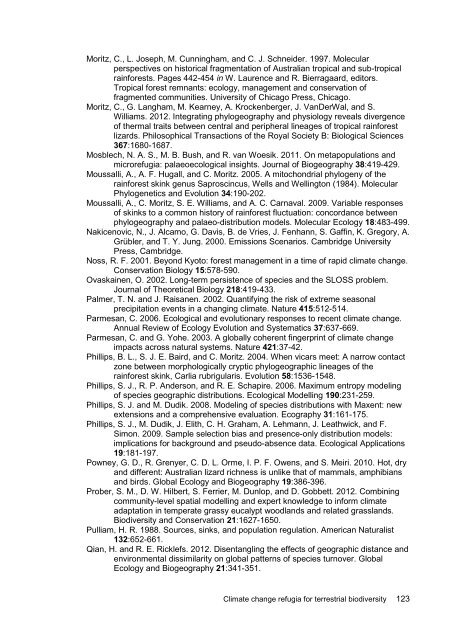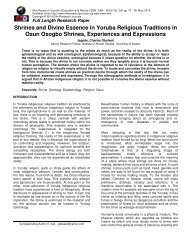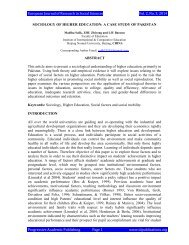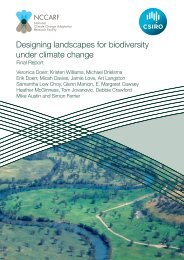Williams-Climate-change-refugia-for-terrestrial-biodiversity_0
Williams-Climate-change-refugia-for-terrestrial-biodiversity_0
Williams-Climate-change-refugia-for-terrestrial-biodiversity_0
Create successful ePaper yourself
Turn your PDF publications into a flip-book with our unique Google optimized e-Paper software.
Moritz, C., L. Joseph, M. Cunningham, and C. J. Schneider. 1997. Molecular<br />
perspectives on historical fragmentation of Australian tropical and sub-tropical<br />
rain<strong>for</strong>ests. Pages 442-454 in W. Laurence and R. Bierragaard, editors.<br />
Tropical <strong>for</strong>est remnants: ecology, management and conservation of<br />
fragmented communities. University of Chicago Press, Chicago.<br />
Moritz, C., G. Langham, M. Kearney, A. Krockenberger, J. VanDerWal, and S.<br />
<strong>Williams</strong>. 2012. Integrating phylogeography and physiology reveals divergence<br />
of thermal traits between central and peripheral lineages of tropical rain<strong>for</strong>est<br />
lizards. Philosophical Transactions of the Royal Society B: Biological Sciences<br />
367:1680-1687.<br />
Mosblech, N. A. S., M. B. Bush, and R. van Woesik. 2011. On metapopulations and<br />
micro<strong>refugia</strong>: palaeoecological insights. Journal of Biogeography 38:419-429.<br />
Moussalli, A., A. F. Hugall, and C. Moritz. 2005. A mitochondrial phylogeny of the<br />
rain<strong>for</strong>est skink genus Saproscincus, Wells and Wellington (1984). Molecular<br />
Phylogenetics and Evolution 34:190-202.<br />
Moussalli, A., C. Moritz, S. E. <strong>Williams</strong>, and A. C. Carnaval. 2009. Variable responses<br />
of skinks to a common history of rain<strong>for</strong>est fluctuation: concordance between<br />
phylogeography and palaeo-distribution models. Molecular Ecology 18:483-499.<br />
Nakicenovic, N., J. Alcamo, G. Davis, B. de Vries, J. Fenhann, S. Gaffin, K. Gregory, A.<br />
Grübler, and T. Y. Jung. 2000. Emissions Scenarios. Cambridge University<br />
Press, Cambridge.<br />
Noss, R. F. 2001. Beyond Kyoto: <strong>for</strong>est management in a time of rapid climate <strong>change</strong>.<br />
Conservation Biology 15:578-590.<br />
Ovaskainen, O. 2002. Long-term persistence of species and the SLOSS problem.<br />
Journal of Theoretical Biology 218:419-433.<br />
Palmer, T. N. and J. Raisanen. 2002. Quantifying the risk of extreme seasonal<br />
precipitation events in a changing climate. Nature 415:512-514.<br />
Parmesan, C. 2006. Ecological and evolutionary responses to recent climate <strong>change</strong>.<br />
Annual Review of Ecology Evolution and Systematics 37:637-669.<br />
Parmesan, C. and G. Yohe. 2003. A globally coherent fingerprint of climate <strong>change</strong><br />
impacts across natural systems. Nature 421:37-42.<br />
Phillips, B. L., S. J. E. Baird, and C. Moritz. 2004. When vicars meet: A narrow contact<br />
zone between morphologically cryptic phylogeographic lineages of the<br />
rain<strong>for</strong>est skink, Carlia rubrigularis. Evolution 58:1536-1548.<br />
Phillips, S. J., R. P. Anderson, and R. E. Schapire. 2006. Maximum entropy modeling<br />
of species geographic distributions. Ecological Modelling 190:231-259.<br />
Phillips, S. J. and M. Dudik. 2008. Modeling of species distributions with Maxent: new<br />
extensions and a comprehensive evaluation. Ecography 31:161-175.<br />
Phillips, S. J., M. Dudik, J. Elith, C. H. Graham, A. Lehmann, J. Leathwick, and F.<br />
Simon. 2009. Sample selection bias and presence-only distribution models:<br />
implications <strong>for</strong> background and pseudo-absence data. Ecological Applications<br />
19:181-197.<br />
Powney, G. D., R. Grenyer, C. D. L. Orme, I. P. F. Owens, and S. Meiri. 2010. Hot, dry<br />
and different: Australian lizard richness is unlike that of mammals, amphibians<br />
and birds. Global Ecology and Biogeography 19:386-396.<br />
Prober, S. M., D. W. Hilbert, S. Ferrier, M. Dunlop, and D. Gobbett. 2012. Combining<br />
community-level spatial modelling and expert knowledge to in<strong>for</strong>m climate<br />
adaptation in temperate grassy eucalypt woodlands and related grasslands.<br />
Biodiversity and Conservation 21:1627-1650.<br />
Pulliam, H. R. 1988. Sources, sinks, and population regulation. American Naturalist<br />
132:652-661.<br />
Qian, H. and R. E. Ricklefs. 2012. Disentangling the effects of geographic distance and<br />
environmental dissimilarity on global patterns of species turnover. Global<br />
Ecology and Biogeography 21:341-351.<br />
<strong>Climate</strong> <strong>change</strong> <strong>refugia</strong> <strong>for</strong> <strong>terrestrial</strong> <strong>biodiversity</strong> 123






